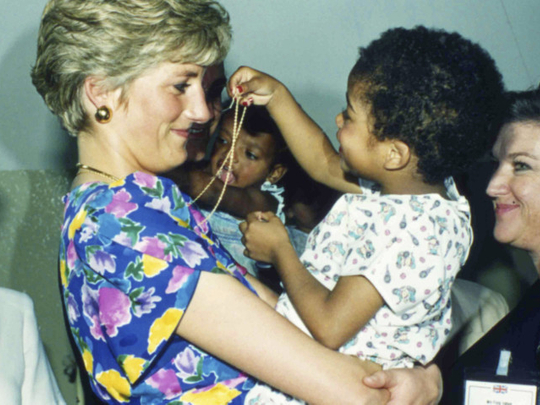
London: I’d like to be a queen of people’s hearts, said Diana, Princess of Wales, during her controversial BBC Panorama interview with Martin Bashir in 1995.
The programme — which was broadcast a few months before her divorce from Prince Charles and two years before her death in a Paris car crash on August 31, 1997 — was a huge gamble for the put-upon, stifled Diana, whose decision to air the royal family’s dirty laundry in public was criticised as tawdry and unbecoming of the wife of the heir to the throne.
But her follow-up remark to that “queen of people’s hearts” line was particularly telling, as Queen Elizabeth II’s then-daughter-in-law said: “But I don’t see myself being queen of this country. I don’t think many people will want me to be queen. Actually, when I say many people, I mean the establishment that I married into, because they have decided that I’m a non-starter.”
And there lies the crux of Diana’s problem — the “people’s princess” had been largely embraced by the public and was viewed as the down-to-earth, human, lovable side of a royal family that had grown distant, but behind closed doors she was seen as a liability who was unstable and unwilling to follow the conservative traditions of her in-laws.
The general population was overwhelmingly on her side, as proved by the nationwide outpouring of grief following her death.
“For a woman who was uneducated and intellectually insecure, who got engaged at a very inexperienced 19, who lived in the goldfish bowl of media attention, who carried the full weight of expectation that she would put up and shut up about everything — from her husband’s infidelity to the suffocating royal protocols — speaking out instead of shrivelling up was a sign of her strength of character. Small wonder that millions of people instinctively responded to that,” said Monica Ali, whose novel Untold Story was inspired by Diana.
Much of the public’s admiration for Diana undoubtedly came as a result of her charitable work, particularly as she chose to support causes that were seen as controversial or dangerous at the time, such as leprosy, anti-landmines and, most memorably, Aids — for which, in 1987, she shook hands with an HIV-positive patient without wearing gloves, helping to dispel widespread ignorance about the disease.
“She had an extra quality that frustrated her critics during her lifetime and has done little to soften their disdain since her death,” according to her equerry and private secretary Patrick Jephson.
“It’s a quality that can’t easily be defined in words. However, for any who saw her with the discarded casualties of life, among whom she found her own purpose, it was easy to recognise. Lepers, Aids orphans, rough sleepers, drug addicts, criminals and the generally unloved found in her the human face of a remote institution.”
Diana’s overall effect on charity was described as “probably more significant than any other person’s in the 20th century” by the UK Institute of Charity Fundraising Managers. This may have left some of her royal colleagues in the shade and under-appreciated, but it could be argued that it should inspire them, that they should strive to rival her legacy.
“Diana’s posthumous influence on the royal family lives on in significant ways, irritating though it must be to be reminded of it. She forced them to raise their game, she enlivened their Hanoverian gene pool,” Michael White wrote in the Guardian.
This is particularly true of her sons, William and Harry, who have been open about the death of their mother in recent weeks and who are continuing her legacy of tackling issues that Britons have traditionally swept under the carpet.
The princes could have easily shunned the topic of mental health given the way depression and bulimia affected Diana, but instead they have fronted a Heads Together campaign in a bid to get people talking about the issue, rather than bottling up problems and showing the stereotypical stiff upper lip.
William has spoken of how he came face-to-face with the issue in his work as an air ambulance pilot, and how he wants his family to be open about their feelings.
“My first callout was to a male suicide and I was told there were five suicides or attempted suicides every day in East Anglia alone. I was shocked by how bad this situation is — suicide is the biggest killer of men under 45 in the UK, which is absolutely appalling,” said William.
“Catherine and I are clear that we want both George and Charlotte to grow up feeling able to talk about their emotions and feelings.”
Diana’s enduring popularity — in 2002 she was ranked third on the BBC’s poll of the 100 Greatest Britons, outranking all of the country’s monarchs — may still over-shadow today’s royals and her sons in particular, but as long as they replicate her openness and charitable work and learn from her mistakes, they too will keep a place in the hearts of the public.
As Diana’s former butler Paul Burrell has said: “She changed the rules so that Kate [the Duchess of Cambridge], for instance, would have an easier passage, an easier life and that her sons could marry and have a fairly ordinary, normal life, that she never had, because her life was played out on the public stage.
“Her legacy are William and Harry and they will continue Diana’s work. They will go forward with everything that was important to her and that’s right.”












